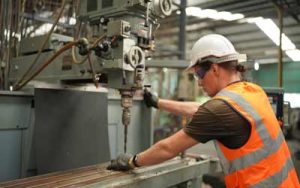
Machining is a fundamental part of the manufacturing industry. Manufacturing companies use machining operations to change the shape, dimensions and properties of raw materials, essentially preparing them for use in the final product. Machining is widely used on metal products, though it can also be used on wood, ceramic, composite and plastic materials. To better understand machining and its common operations, keep reading.
Turning
Turning involves the use of a special cutting tool that removes material from a rotating device to create a cylindrical shape. The cutting tool, which is typically a non-rotary bit, gradually removes the material as the workpiece rotates. With that said, there are several different turning operations, including tapered turning, spherical turning, hard turning, facing, parting and grooving, each of which has its own specific function and characteristics.
Drilling
Perhaps the most common machining operation, drilling is a cutting process that’s characterized by the use of a rotary drill bit to cut a circular-shaped hole into a solid material. The drill bit is placed directly against the material, at which point it’s powered to create hundreds or even thousands of rotations per minute. The force of these revolutions allows the bit to drive itself into the material, creating a hole in its wake.
Boring
While drilling is used to create a hole in a material, boring is used to enlarge an existing hole. The general idea behind this process is to create more precise measurements and dimensions of the hole. In boring, a special cutting tool with a bent tip is used to “push” through the existing hole in a spinning workpiece. As a result, boring operations are typically performed in the final stages of a product’s production.
Reaming
Reaming is a machining operation that involves the use of a rotary cutting tool known as a reamer to remove a small amount of material from a hole that has already been drilled. When drilling into metal or any other material, some of the material is left behind in the hole. To eliminate this excess material, machining professionals use a reamer.
Milling
Finally, milling is a machining operation that involves the use of a rotating tool with two or more cutting edges to create a straight, symmetrical surface. There are two forms of milling: peripheral and face milling.
These are just a few of the most common machining operations. Others include shaping, broaching, sawing and planing.
